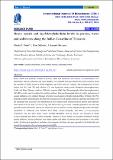| dc.description.abstract | Heavy metals and pesticide residues in prawns, water and sediments, and sources of contamination were
determined. Prawns, sediments and water samples were collected from agricultural farms and estuarine, along
the coastline of Indian Ocean in Kisiju, Bagamoyo and Kilwa zones in Tanzania. The concentration of heavy
metals; zinc (Zn), lead (Pb) and cadmium (Cd) was determined using Atomic Absorption Spectrophotometry
(AAS), and Direct Mercury Analyzer (DMA) for mercury (Hg). Gas Chromatography-Mass Spectrophotometry
(GC-MS) was also used to analyze for pesticide residues. Data on demographic characterization and sources of
aquatic pollution were obtained through structured questionnaires. Results indicated that, fertilizers (60.7%),
pesticides (59.8%) and herbicides (60.7%) were the main sources of aquatic pollution. Cyberdip and Utupa were
the chemicals used in prawns. The distribution of heavy metals mean concentrations in prawns and sediments
were found to be in order Zn>Pb>Cd>Hg, and Pb>Zn>Cd>Hg in water. Lambda-cyhalothrin was the only
pesticide residue detected in prawns and sediments and not detected in water. Significant high levels of lambdacyhalothrin in sediments were detected from Kisiju (16.49±2.36mg/kg) and Kilwa (12.21±3.24mg/kg)
respectively. On the other hand, lowest Lambda-cyhalothrin level in prawns was detected in Kisiju
(2.26±0.51mg/kg) and Kilwa (0.28±0.40mg/kg). Presence of heavy metals and Lambda-cyhalothrin indicate
marine pollution. Marine pollutants may impair quality and safety of prawns and by-products to the public
health. Monitoring of agricultural and other anthropogenic activities in the area especially in the Rufiji delta and
around the mangroves where prawns spawn is inevitable. | en_US |

